Framing Concepts of Agriculture 5.0 via Bipartite Analysis
Abstract
1. Introduction
2. Materials and Methods
2.1. Data Source
2.2. Identification
- (Class 2) Terms representing digital advancements, such as “API” (Application Programming Interface) [51];
- (Class 3) Agriculture—terms related to land use, plant, and livestock systems.
- Class 1—<Ontol* or KOS or “Knowledge Organization System*” or Semantic*>;
- Class 2—<Data or Mobile or App or API* or “Digital Application Development” or “Digital Transformation”>;
- Class 3—<Agriculture or Farm* or Livestock>.
2.3. Screening, Eligibility and Inclusion
2.4. Network Analysis
- Bipartite—nodes link only between keywords and journals, not between nodes within the same set;
- Undirected—relationships lack hierarchy and reflect shared topics;
- Weighted—edges include information on how frequently a keyword appears in a particular journal.
3. Results
3.1. Identification and Selection of Conceptual Assets from the Bipartite Keyword–Journal Network
3.2. Economy: The Core Dimension of Sustainability in Agriculture 4.0
- Detection—identifying or detecting beneficial or harmful elements within agricultural systems;
- Forecasting—using historical data to predict future trends or events;
- Framework—providing guidelines for building useful systems or solutions;
- Mapping—assigning geographic locations to specific land cover or crop classes;
- Modeling—creating representations that accurately reflect reality;
- Monitoring—recording and analyzing data over time to track processes;
- Policy—developing principles, rules, or guidelines to achieve long-term sustainability goals;
- Privacy—ensuring individuals’ control over how their data are collected and utilized;
- Security—providing reliability, safety, and trust in the use of technological applications.
4. Discussion
4.1. Socioenvironmental Dimensions of Sustainability in Agriculture 5.0
4.2. Developing a Framework of Conceptual Assets of Agriculture 5.0
5. Conclusions
Author Contributions
Funding
Data Availability Statement
Acknowledgments
Conflicts of Interest
Appendix A
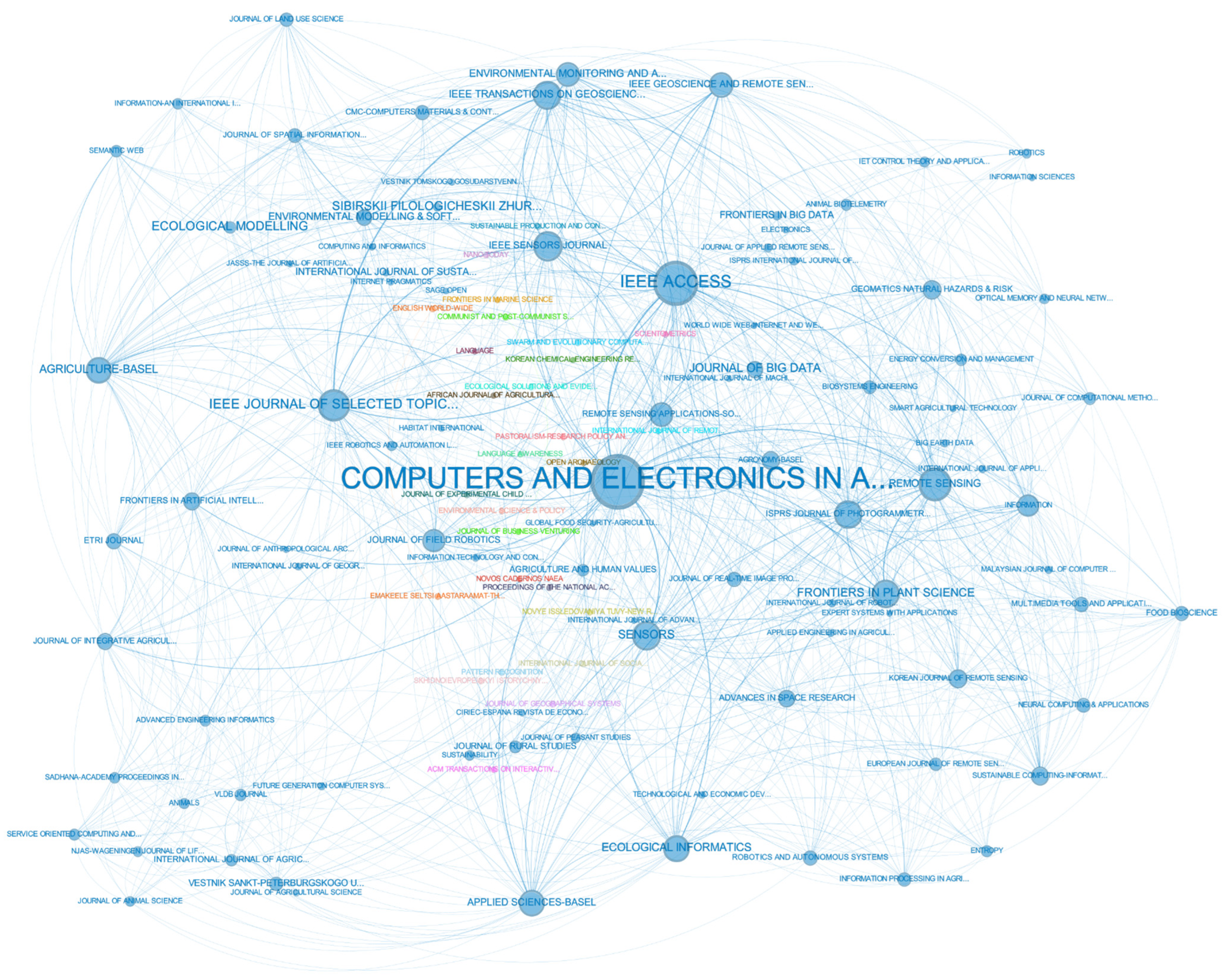
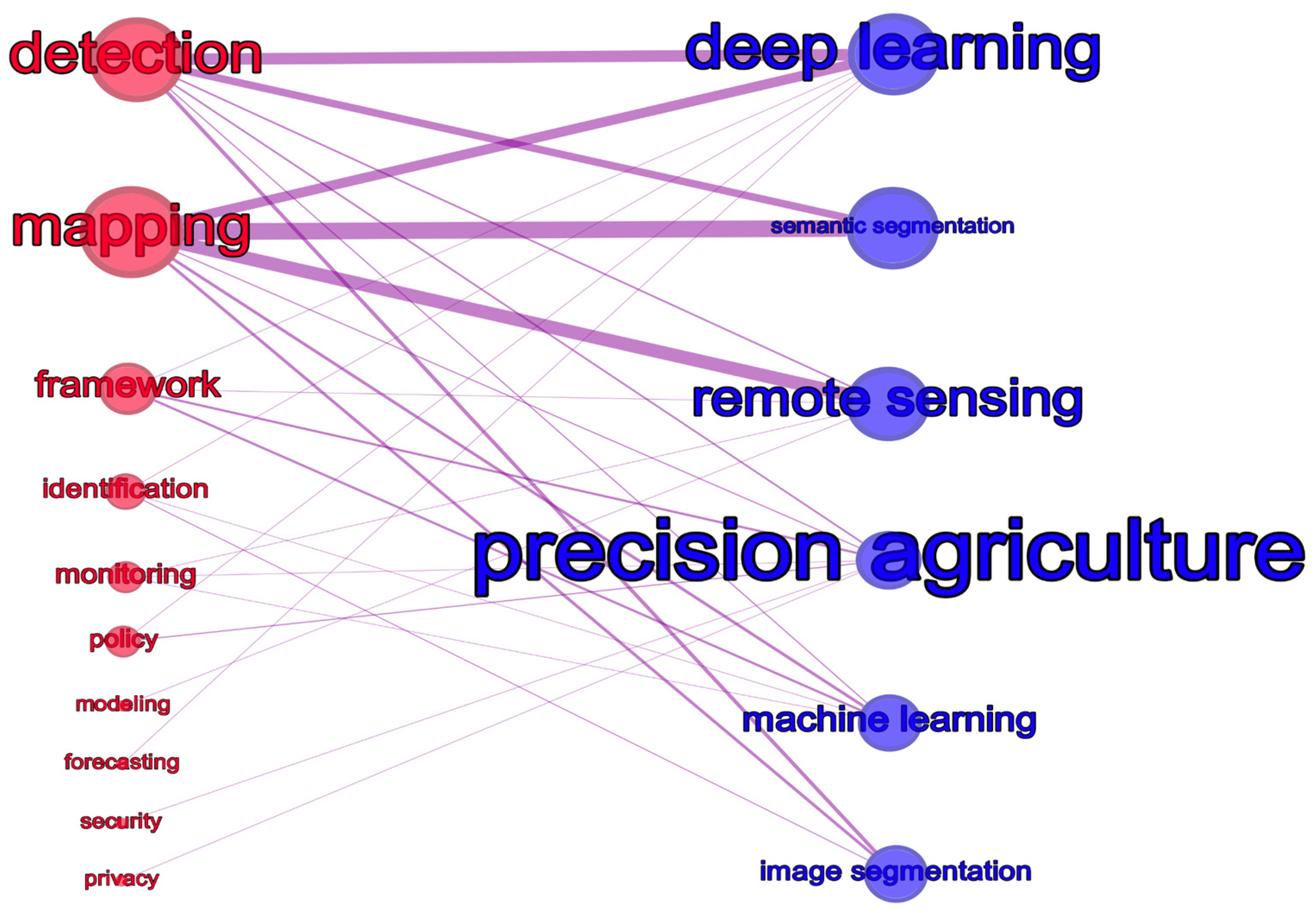
| Application | Publication DOI | Publication Year | Superhub Keywords |
|---|---|---|---|
| detection | 10.1007/s11554-023-01264-0 | 2023 | deep learning, precision agriculture |
| detection | 10.1016/j.compag.2020.105302 | 2020 | deep learning |
| detection | 10.1016/j.compag.2020.105504 | 2020 | deep learning |
| detection | 10.1016/j.compag.2020.105760 | 2020 | precision agriculture |
| detection | 10.1016/j.compag.2023.107881 | 2023 | deep learning, semantic segmentation |
| detection | 10.1016/j.inpa.2022.05.002 | 2023 | semantic segmentation |
| detection | 10.1016/j.isprsjprs.2023.09.021 | 2023 | deep learning |
| detection | 10.1016/j.rsase.2021.100627 | 2021 | deep learning, semantic segmentation |
| detection | 10.1016/j.suscom.2022.100759 | 2022 | deep learning, semantic segmentation |
| detection | 10.1109/ACCESS.2020.2991354 | 2020 | deep learning, semantic segmentation, precision agriculture |
| detection | 10.1109/ACCESS.2021.3108003 | 2021 | deep learning, semantic segmentation |
| detection | 10.1109/JSEN.2021.3071290 | 2021 | deep learning, semantic segmentation, image segmentation |
| detection | 10.1109/LRA.2023.3320018 | 2023 | image segmentation |
| detection | 10.3390/agriculture11020131 | 2021 | deep learning |
| detection | 10.3390/rs15215124 | 2023 | deep learning, semantic segmentation, remote sensing |
| detection | 10.3390/s20185292 | 2020 | deep learning, remote sensing, image segmentation |
| detection | 10.3390/s21144801 | 2021 | semantic segmentation |
| detection | 10.3390/s22197131 | 2022 | image segmentation |
| detection | 10.7780/kjrs.2021.37.3.1 | 2021 | deep learning, semantic segmentation |
| detection & identification | 10.1016/j.compag.2021.106451 | 2021 | image segmentation, machine learning |
| detection & identification | 10.1109/TGRS.2021.3093041 | 2022 | deep learning, image segmentation |
| detection & identification | 10.3390/rs14092004 | 2022 | deep learning |
| detection & mapping | 10.1016/j.biosystemseng.2020.05.022 | 2020 | deep learning |
| detection & mapping | 10.1016/j.compag.2019.03.028 | 2019 | machine learning |
| detection & mapping | 10.1016/j.compag.2023.108217 | 2023 | semantic segmentation |
| detection & mapping | 10.1016/j.isprsjprs.2021.08.024 | 2021 | deep learning, semantic segmentation |
| detection & mapping | 10.1080/19475705.2023.2196370 | 2023 | deep learning, semantic segmentation, remote sensing |
| detection & mapping | 10.1109/LRA.2019.2901987 | 2019 | deep learning |
| forecasting | 10.1016/j.enconman.2020.113098 | 2020 | deep learning |
| framework | 10.1109/ACCESS.2021.3128178 | 2021 | deep learning |
| framework | 10.1109/ACCESS.2022.3198099 | 2022 | precision agriculture |
| framework | 10.1109/JSTARS.2021.3139155 | 2022 | precision agriculture |
| framework | 10.1117/1.JRS.16.024519 | 2022 | machine learning |
| framework | 10.1145/3453172 | 2021 | remote sensing |
| framework | 10.1186/s40537-023-00729-0 | 2023 | precision agriculture, machine learning |
| framework | 10.21638/11701/spbu10.2022.206 | 2022 | precision agriculture |
| framework | 10.32604/cmc.2023.030924 | 2023 | machine learning |
| framework | 10.3389/fdata.2020.00012 | 2020 | machine learning |
| mapping | 10.1007/s00521-020-05561-8 | 2023 | semantic segmentation |
| mapping | 10.1007/s10661-022-10848-5 | 2023 | deep learning, semantic segmentation, remote sensing, image segmentation |
| mapping | 10.1007/s11042-022-12141-6 | 2022 | semantic segmentation |
| mapping | 10.1016/j.asr.2023.05.007 | 2023 | semantic segmentation, remote sensing |
| mapping | 10.1016/j.compag.2020.105277 | 2020 | deep learning |
| mapping | 10.1016/j.compag.2020.105369 | 2020 | semantic segmentation, remote sensing |
| mapping | 10.1016/j.compag.2021.106482 | 2021 | deep learning, semantic segmentation |
| mapping | 10.1016/j.compag.2022.106731 | 2022 | deep learning, remote sensing |
| mapping | 10.1016/j.compag.2023.107754 | 2023 | semantic segmentation |
| mapping | 10.1016/j.ecoinf.2023.102078 | 2023 | deep learning, semantic segmentation |
| mapping | 10.1016/j.fbio.2023.102848 | 2023 | semantic segmentation, machine learning |
| mapping | 10.1016/j.isprsjprs.2021.09.005 | 2021 | deep learning, semantic segmentation |
| mapping | 10.1016/j.isprsjprs.2022.01.007 | 2022 | deep learning, semantic segmentation |
| mapping | 10.1016/j.isprsjprs.2023.06.014 | 2023 | semantic segmentation |
| mapping | 10.1016/j.jag.2021.102511 | 2021 | remote sensing |
| mapping | 10.1016/j.robot.2023.104581 | 2024 | semantic segmentation, precision agriculture |
| mapping | 10.1080/03066150.2012.665890 | 2012 | remote sensing |
| mapping | 10.1080/22797254.2023.2181874 | 2023 | semantic segmentation |
| mapping | 10.1109/ACCESS.2019.2913442 | 2019 | semantic segmentation |
| mapping | 10.1109/ACCESS.2021.3069882 | 2021 | remote sensing |
| mapping | 10.1109/JSTARS.2021.3132259 | 2022 | image segmentation, machine learning |
| mapping | 10.1109/JSTARS.2022.3208185 | 2022 | remote sensing, image segmentation |
| mapping | 10.1109/JSTARS.2023.3301158 | 2023 | remote sensing |
| mapping | 10.1109/LGRS.2020.3037976 | 2022 | semantic segmentation, image segmentation |
| mapping | 10.2316/J.2022.206-0730 | 2022 | remote sensing |
| mapping | 10.3389/fpls.2022.1030595 | 2023 | semantic segmentation, remote sensing |
| mapping | 10.3389/fpls.2023.1196634 | 2023 | deep learning, remote sensing |
| mapping | 10.3389/fpls.2023.1228590 | 2023 | deep learning, semantic segmentation, remote sensing |
| mapping | 10.3390/agriculture12111894 | 2022 | machine learning |
| mapping | 10.3390/app12168234 | 2022 | deep learning, semantic segmentation, remote sensing |
| mapping | 10.3390/e23040435 | 2021 | semantic segmentation |
| mapping | 10.3390/ijgi12020081 | 2023 | machine learning |
| mapping | 10.3390/info12060230 | 2021 | deep learning, semantic segmentation, remote sensing |
| mapping | 10.3390/info13050259 | 2022 | deep learning |
| mapping | 10.3390/rs11172008 | 2019 | semantic segmentation, remote sensing |
| mapping | 10.3390/rs12132159 | 2020 | deep learning |
| mapping | 10.3390/rs13040612 | 2021 | deep learning, semantic segmentation |
| mapping | 10.3390/rs13214370 | 2021 | semantic segmentation, remote sensing |
| mapping | 10.3390/rs13214411 | 2021 | remote sensing |
| mapping | 10.3390/rs14092157 | 2022 | remote sensing |
| mapping | 10.3390/rs14194694 | 2022 | semantic segmentation |
| mapping | 10.3390/rs15102500 | 2023 | deep learning, semantic segmentation, remote sensing |
| mapping | 10.3390/sens12060230 | 2020 | deep learning |
| mapping | 10.9713/kcer.2019.57.2.274 | 2019 | semantic segmentation |
| mapping & detection | 10.1109/TGRS.2020.3029841 | 2021 | image segmentation |
| mapping & detection | 10.3390/agronomy13030635 | 2023 | deep learning, remote sensing |
| mapping & detection | 10.1002/rob.21877 | 2020 | semantic segmentation, precision agriculture |
| mapping & detection | 10.1109/ACCESS.2023.3308909 | 2023 | semantic segmentation, remote sensing, machine learning |
| mapping & modeling | 10.1080/1747423X.2021.1879296 | 2021 | remote sensing |
| modeling | 10.3390/rs12030342 | 2020 | remote sensing |
| monitoring | 10.1186/s40317-021-00248-w | 2021 | machine learning |
| monitoring | 10.3390/rs15184403 | 2023 | remote sensing |
| monitoring | 10.3390/s20205768 | 2020 | precision agriculture |
| policy | 10.1016/j.jrurstud.2020.10.040 | 2022 | precision agriculture |
| policy | 10.1016/j.jrurstud.2020.10.040 | 2020 | precision agriculture |
| policy | 10.3233/JCM-226522 | 2023 | deep learning |
| privacy & security | 10.3390/su151310264 | 2023 | precision agriculture |
References
- Xu, X.; Lu, Y.; Vogel-Heuser, B.; Wang, L. Industry 4.0 and Industry 5.0—Inception, conception and perception. J. Manuf. Syst. 2021, 61, 530–535. [Google Scholar] [CrossRef]
- Dimitrijević, M.S. Technological progress in the function of productivity and sustainability of agriculture: The case of innovative countries and the Republic of Serbia. J. Agric. Food Res. 2023, 14, 100856. [Google Scholar] [CrossRef]
- Mulla, D.J. Twenty five years of remote sensing in precision agriculture: Key advances and remaining knowledge gaps. Biosyst. Eng. 2013, 114, 358–371. [Google Scholar] [CrossRef]
- Crocombe, R.A. Portable Spectroscopy. Appl. Spectrosc. 2018, 72, 1701–1751. [Google Scholar] [CrossRef]
- Tripodi, P.; Massa, D.; Venezia, A.; Cardi, T. Sensing Technologies for Precision Phenotyping in Vegetable Crops: Current Status and Future Challenges. Agronomy 2018, 8, 57. [Google Scholar] [CrossRef]
- Sishodia, R.P.; Ray, R.L.; Singh, S.K. Applications of Remote Sensing in Precision Agriculture: A Review. Remote Sens. 2020, 12, 3136. [Google Scholar] [CrossRef]
- Khurana, U.; Srinivas, K.; Galhotra, S.; Samulowitz, H. A Vision for Semantically Enriched Data Science. arXiv 2023, arXiv:2303.01378. [Google Scholar]
- Barbedo, J.G.A. Data Fusion in Agriculture: Resolving Ambiguities and Closing Data Gaps. Sensors 2022, 22, 2285. [Google Scholar] [CrossRef]
- Gebresenbet, G.; Bosona, T.; Patterson, D.; Persson, H.; Fischer, B.; Mandaluniz, N.; Chirici, G.; Zacepins, A.; Komasilovs, V.; Pitulac, T.; et al. A concept for application of integrated digital technologies to enhance future smart agricultural systems. Smart Agric. Technol. 2023, 5, 100255. [Google Scholar] [CrossRef]
- FAO. The Future of Food and Agriculture—Drivers and Triggers for Transformation; The Future of Food and Agriculture, 3; FAO: Rome, Italy, 2022. [Google Scholar]
- Matt, D.T.; Modrák, V.; Zsifkovits, H. Implementing Industry 4.0 in SMEs: Concepts, Examples and Applications; Palgrave Macmillan: Cham, Switzerland, 2021; 429p. [Google Scholar]
- Breque, M.; De Nul, L.; Petridis, A. Industry 5.0—Towards a Sustainable, Human-Centric and Resilient European Industry; Publications Office of the European Union: Copenhagen, Denmark, 2021; 45p. [Google Scholar]
- Meshram, V.; Patil, K.; Meshram, V.; Hanchate, D.; Ramkteke, S.D. Machine learning in agriculture domain: A state-of-art survey. Artif. Intell. Life Sci. 2021, 1, 100010. [Google Scholar] [CrossRef]
- Massruhá, S.M.F.S.; Leite, M.A.A.; Luchiari Junior, A.; Evangelista, S.R.M. Digital transformation in the field towards sustainable and smart agriculture. In Digital Agriculture: Research, Development and Innovation in Production Chains; Massruhá, S.M.F.S., Leite, M.A.A., Oliveira, S.R.M., Meira, C.A.A., Luchiari Junior, A., Bolfe, E.L., Eds.; Embrapa: Brasília, Brazil, 2023; cap. 1; pp. 17–35. [Google Scholar]
- Fraser, E.D.G.; Campbell, M. Agriculture 5.0: Reconciling Production with Planetary Health. One Earth 2019, 1, 278–280. [Google Scholar] [CrossRef]
- Saiz-Rubio, V.; Rovira-Más, F. From Smart Farming towards Agriculture 5.0: A Review on Crop Data Management. Agronomy 2020, 10, 207. [Google Scholar] [CrossRef]
- Auernhammer, H. Precision farming—The environmental challenge. Comput. Electron. Agric. 2001, 30, 31–43. [Google Scholar] [CrossRef]
- Cuadra, S.V.; Victoria, D.C.; Pellegrino, G.Q.; Bolfe, E.L.; Monteiro, J.E.B.A.; Assad, E.D.; Oliveira, A.F.; Fasiaben, M.C.R.; Martha Júnior, G.B.; Batistella, M.; et al. Agroenvironmental modeling and the digital transformation of agriculture. In Digital Agriculture: Research, Development and Innovation in Production Chains; Massruhá, S.M.F.S., Leite, M.A.A., Oliveira, S.R.M., Meira, C.A.A., Luchiari Junior, A., Bolfe, E.L., Eds.; Embrapa: Brasília, Brazil, 2023; pp. 51–70. [Google Scholar]
- Etienne, A.; Saraswat, D. Machine learning approaches to automate weed detection by UAV based sensors. In Autonomous Air and Ground Sensing Systems for Agricultural Optimization and Phenotyping IV; 110080R; SPIE: Bellingham, WA, USA, 2019. [Google Scholar]
- Dehkordi, R.H.; Burgeon, V.; Fouche, J.; Gomez, E.P.; Cornelis, J.-T.; Nguyen, F.; Denis, A.; Meersmans, J. Using UAV Collected RGB and Multispectral Images to Evaluate Winter Wheat Performance across a Site Characterized by Century-Old Biochar Patches in Belgium. Remote Sens. 2020, 12, 2504. [Google Scholar] [CrossRef]
- Santos, L.B.; Bastos, L.M.; Oliveira, M.F.; Soares, P.L.M.; Ciampitti, I.A.; Silva, R.P. Identifying Nematode Damage on Soybean through Remote Sensing and Machine Learning Techniques. Agronomy 2022, 12, 2404. [Google Scholar] [CrossRef]
- Grego, C.R.; Speranza, E.A.; Rodrigues, G.C.; Luchiari Júnior, A.; Vendrusculo, L.G.; Rodrigues, C.A.G.; Inamasu, R.Y.; Vaz, C.M.P.; Rabello, L.M.; Jorge, L.A.C.; et al. Technologies developed in precision agriculture. In Digital Agriculture: Research, Development and Innovation in Production Chains; Massruhá, S.M.F.S., Leite, M.A.A., Oliveira, S.R.M., Meira, C.A.A., Luchiari Junior, A., Bolfe, E.L., Eds.; Embrapa: Brasília, Brazil, 2023; pp. 125–144. [Google Scholar]
- He, L.; Schupp, J. Sensing and Automation in Pruning of Apple Trees: A Review. Agronomy 2018, 8, 211. [Google Scholar] [CrossRef]
- Iost Filho, F.H.; Pazin, J.B.; Alves, T.M.; Koch, R.L.; Yamamoto, P.T. How does the digital transformation of agriculture affect the implementation of Integrated Pest Management? Front. Sustain. Food Syst. 2022, 6, 972213. [Google Scholar] [CrossRef]
- Anastasiou, E.; Fountas, S.; Voulgaraki, M.; Psiroukis, V.; Koutsiaras, M.; Kriezi, O.; Lazarou, E.; Vatsanidou, A.; Fu, L.; Bartolo, F.; et al. Precision farming technologies for crop protection: A meta-analysis. Smart Agric. Technol. 2023, 5, 100323. [Google Scholar] [CrossRef]
- Nackley, L.L.; Warneke, B.; Fessler, L.; Pscheidt, J.W.; Lockwood, D.; Wright, W.C.; Sun, X.; Fulcher, A. Variable-rate Spray Technology Optimizes Pesticide Application by Adjusting for Seasonal Shifts in Deciduous Perennial Crops. HortTechnology 2021, 31, 479–489. [Google Scholar] [CrossRef]
- Basso, B.; Antle, J. Digital agriculture to design sustainable agricultural systems. Nat. Sustain. 2020, 3, 254–256. [Google Scholar] [CrossRef]
- Donaldson, A. Digital from farm to fork: Infrastructures of quality and control in food supply chains. J. Rural. Stud. 2022, 91, 228–235. [Google Scholar] [CrossRef]
- Aquilani, C.; Confessore, A.; Bozzi, R.; Sirtori, F.; Pugliese, C. Precision Livestock Farming technologies in pasture-based livestock systems. Animal 2022, 16, 100429. [Google Scholar] [CrossRef] [PubMed]
- Niloofar, P.; Francis, D.; Lazarova-Molnar, S.; Vulpe, A.; Vochin, M.; Suciu, G.; Balanescu, M.; Anestis, V.; Bartzanas, T. Data-Driven Decision Support in Livestock Farming for Improved Animal Health, Welfare and Greenhouse Gas Emissions: Overview and Challenges. Comput. Electron. Agric. 2021, 190, 106406. [Google Scholar] [CrossRef]
- Neethirajan, S.; Kemp, B. Digital Livestock Farming. Sens. Bio-Sens. Res. 2021, 32, 100408. [Google Scholar] [CrossRef]
- Fuentes, S.; Gonzales Viejo, C.; Tongson, E.; Dunshea, F. The Livestock Farming Digital Transformation: Implementation of New and Emerging Technologies Using Artificial Intelligence. Anim. Health Res. Rev. 2022, 23, 59–71. [Google Scholar] [CrossRef]
- Rayner, K.L.; Wilson, M.E. Distance examination of livestock with drones—An effective method for assessing health and welfare. Aust. Vet. J. 2024, 102, 293–295. [Google Scholar] [CrossRef] [PubMed]
- Freitas, R.G.; Pereira, F.R.S.; Reis, A.A.; Magalhães, S.G.; Gleyce, K.D.A.; Figueiredo, L.R.A. Estimating pasture aboveground biomass under an integrated crop-livestock system based on spectral and texture measures derived from UAV images. Comput. Electron. Agric. 2022, 198, 107112. [Google Scholar] [CrossRef]
- Silva, Y.F.; Valadares, R.V.; Dias, H.B.; Cuadra, S.V.; Campbell, E.E.; Lamparelli, R.A.C.; Moro, E.; Battisti, R.; Alves, M.R.; Magalhães, P.S.G.; et al. Intense Pasture Management in Brazil in an Integrated Crop-Livestock System Simulated by the DayCent Model. Sustainability 2022, 14, 3517. [Google Scholar] [CrossRef]
- Valani, G.; Fachin Martíni, A.; Silva, L.; Bovi, R.; Cooper, M. Soil quality assessments in integrated crop–livestock–forest systems: A review. Soil Use Manag. 2021, 37, 22–36. [Google Scholar] [CrossRef]
- Martin, G.; Moraine, M.; Ryschawy, J.; Ryschawy, J.; Magne, M.-A.; Asai, M.; Sarthou, J.-P.; Duru, M.; Therond, O. Crop–livestock integration beyond the farm level: A review. Agron. Sustain. Dev. 2016, 36, 53. [Google Scholar] [CrossRef]
- Kotobiodjo, M.N.; Egah, J.; Dato, S.M.; Baco, M.N. Understanding the drivers of rural household scaling up of integrated crop-livestock-forestry systems. A systematic review and bibliometric analysis. Front. Sustain. Food Syst. 2024, 8, 1267686. [Google Scholar] [CrossRef]
- Carvalho, P.C.F.; Anghinoni, I.; Moraes, A.; Souza, E.D.; Sulc, R.M.; Lang, C.R.; Flores, J.P.C.; Lopes, M.L.T.; Silva, J.L.S.; Conte, O.; et al. Managing grazing animals to achieve nutrient cycling and soil improvement in no-till integrated systems. Nutr. Cycl. Agroecosyst. 2010, 88, 259–273. [Google Scholar] [CrossRef]
- Assmann, J.; Anghinoni, I.; Martins, A.; Costa, S.; Cecagno, D.; Carlos, F.; Carvalho, P.C.F. Soil carbon and nitrogen stocks and fractions in a long-term integrated crop–livestock system under no-tillage in southern Brazil. Agric. Ecosyst. Environ. 2013, 190, 52–59. [Google Scholar] [CrossRef]
- Giro, A.; Pezzopane, J.R.M.; Barioni Junior, W.; Pedroso, A.F.; Lemes, A.P.; Botta, D.; Romanello, N.; Barreto, A.N.; Garcia, A.R. Behavior and body surface temperature of beef cattle in integrated crop-livestock systems with or without tree shading. Sci. Total Environ. 2019, 684, 587–596. [Google Scholar] [CrossRef]
- Power, A. Ecosystem services and agriculture: Tradeoffs and synergies. Phil. Trans. R. Soc. B 2010, 365, 2959–2971. [Google Scholar] [CrossRef] [PubMed]
- Lemaire, G.; Franzluebbers, A.; Carvalho, P.C.F.; Dedieu, B. Integrated crop–livestock systems: Strategies to achieve synergy between agricultural production and environmental quality. Agric. Ecosyst. Environ. 2014, 190, 4–8. [Google Scholar] [CrossRef]
- van Noordwijk, M.; Gitz, V.; Minang, P.A.; Dewi, S.; Leimona, B.; Duguma, L.; Pingault, N.; Meybeck, A. People-Centric Nature-Based Land Restoration through Agroforestry: A Typology. Land 2020, 9, 251. [Google Scholar] [CrossRef]
- Telwala, W. Unlocking the potential of agroforestry as a nature-based solution for localizing sustainable development goals: A case study from a drought-prone region in rural India. Nat.-Based Solut. 2023, 3, 100045. [Google Scholar] [CrossRef]
- Bolfe, E.L.; Victoria, D.C.; Sano, E.E.; Silva, G.B.S.; Massruha, S.M.F.S.; Oliveira, A.F. Potential for agricultural expansion in degraded pasture lands in Brazil based on geospatial databases. Land 2024, 13, 200. [Google Scholar] [CrossRef]
- Adrian, A.M.; Norwood, S.H.; Mask, P.L. Producers’ perceptions and attitudes toward precision agriculture technologies. Comput. Electron. Agric. 2005, 48, 256–271. [Google Scholar] [CrossRef]
- Cortner, O.; Garrett, R.D.; Valentim, J.F.; Ferreira, J.; Niles, M.T.; Reis, J.; Gil, J. Perceptions of integrated crop-livestock systems for sustainable intensification in the Brazilian Amazon. Land Use Policy 2019, 82, 841–853. [Google Scholar] [CrossRef]
- Bolfe, E.L.; Jorge, L.A.C.; Sanches, I.D.; Luchiari Junior, A.; Costa, C.C.; Victoria, D.C.; Inamasu, R.Y.; Grego, C.R.; Ferreira, V.R.; Ramirez, A.R. Precision and Digital Agriculture: Adoption of Technologies and Perception of Brazilian Farmers. Agriculture 2020, 10, 653. [Google Scholar] [CrossRef]
- San Emeterio de la Parte, M.; Martínez-Ortega, J.-F.; Castillejo, P.; Lucas-Martínez, N. Spatio-temporal semantic data management systems for IoT in agriculture 5.0: Challenges and future directions. Internet Things 2024, 25, 101030. [Google Scholar] [CrossRef]
- Romani, L.A.S.; Evangelista, S.R.M.; Vacari, I.; Apolinário, D.R.F.; Vaz, G.J.; Speranza, E.A.; Barbosa, L.A.F.; Drucker, D.P.; Massruhá, S.M.F.S. AgroAPI platform: An initiative to support digital solutions for agribusiness ecosystems. Smart Agric. Technol. 2023, 5, 100247. [Google Scholar] [CrossRef]
- Page, M.J.; McKenzie, J.E.; Bossuyt, P.M.; Boutron, I.; Hoffmann, T.C.; Mulrow, C.D.; Shamseer, L.; Tetzlaff, J.M.; Akl, E.A.; Brennan, S.E.; et al. The PRISMA 2020 statement: An updated guideline for reporting systematic reviews. Syst. Rev. 2021, 10, 89. [Google Scholar] [CrossRef]
- Fletcher, A.J. Applying critical realism in qualitative research: Methodology meets method. Int. J. Soc. Res. Methodol. 2017, 20, 181–194. [Google Scholar] [CrossRef]
- Zheng, Y.L.; He, Q.-Y.; Quian, P.; Li, Z. Construction of the Ontology-Based Agricultural Knowledge Management System. J. Integr. Agric. 2012, 11, 700–709. [Google Scholar] [CrossRef]
- Dhillon, I.S. Co-clustering documents and words using bipartite spectral graph partitioning. In Proceedings of the Seventh ACM SIGKDD International Conference on Knowledge Discovery and Data Mining 2001, San Francisco, CA, USA, 26–29 August 2001; pp. 269–274. [Google Scholar]
- Blondel, V.D.; Guillaume, J.-L.; Lambiotte, R.; Lefebvre, E. Fast unfolding of communities in large networks. J. Stat. Mech. Theory Exp. 2008, 2008, P10008. [Google Scholar] [CrossRef]
- Ramsey, J.L. On Not Defining Sustainability. J. Agric. Environ. Ethics 2015, 28, 1075–1087. [Google Scholar] [CrossRef]
- Gao, Y.-A.; Zeng, Y.; Cai, S.-M. Influence network in the Chinese stock market. J. Stat. Mech. Theory Exp. 2015, 2015, P03017. [Google Scholar] [CrossRef]
- Barabási, A.-L.; Albert, R. Emergence of Scaling in Random Networks. Science 1999, 286, 509–512. [Google Scholar] [CrossRef] [PubMed]
- Barabási, A.-L. Network Science; Cambridge University Press: Cambridge, UK, 2016; 456p. [Google Scholar]
- Janssen, S.; Andersen, E.; Athanasiadis, I.; Ittersum, M.K. A database for integrated assessment of European agricultural systems. Environ. Sci. Policy 2009, 12, 573–587. [Google Scholar] [CrossRef]
- Mendes, J.; Carvalho, N.G.P.; Mourarias, M.N.; Careta, C.B.; Zuin, V.G.; Gerolamo, M.C. Dimensions of digital transformation in the context of modern agriculture. Sustain. Prod. Consum. 2022, 34, 613–637. [Google Scholar] [CrossRef]
- Dabara, D.; Chiwuzie, A. Female-Led agrarian households and the question of sustainable land and food security in an emerging economy: Evidence from Tula Buale. Habitat Int. 2022, 120, 102512. [Google Scholar] [CrossRef]
- Yoon, J.; Park, H.W. Pattern and trend of scientific knowledge production in North Korea by a semantic network analysis of papers in journal titled technological innovation. Scientometrics 2020, 124, 1421–1438. [Google Scholar] [CrossRef]
- Gil, Y.; Garijo, D.; Khider, D.; Knoblock, C.A.; Ratnakar, V.; Osorio, M.; Vargas, H.; Pham, M.; Pujara, J.; Shbita, B.; et al. Artificial Intelligence for Modeling Complex Systems: Taming the Complexity of Expert Models to Improve Decision Making. ACM Trans. Interact. Intell. Syst. 2020, 11, 1–49. [Google Scholar] [CrossRef]
- Dumit, V.I.; Ammar, A.; Bakker, M.I. From principles to reality. FAIR implementation in the nanosafety community. Nano Today 2023, 51, 101923. [Google Scholar] [CrossRef]
- Guimarães, C.S.D.; Mendonça, M.A.F.C.; Cardoso, I.M. The relationship between culture and nature and the diversity of peasant agroecosystem: An aesthetic-visual perception (PT-Br). Novos Cad. NAEA 2023, 26, 131–154. [Google Scholar]
- Morehouse, K.N.; Maddox, K.; Banaji, M.R. All human social groups are human, but some are more human than others: A comprehensive investigation of the implicit association of Human to US racial/ethnic groups. Proc. Natl. Acad. Sci. USA 2023, 120, e2300995120. [Google Scholar] [CrossRef]
- Paholok, I.; Hrynokh, N. Klechalny custom as a spiritual phenomenon of Ukrainian culture. Skhidnoievropeiskyi Istorychnyi Visnyk 2020, 17, 212–218. [Google Scholar] [CrossRef]
- Ondar, C.G.; Byrynnai, S.L.; Tyulyush, A.C. The uses of tamga in Tuvan culture: Antiquity, traditionalism and modernity. New Res. Tuva 2021, 1, 107–130. [Google Scholar]
- Hood, A.S.C.; Shackelford, G.E.; Christie, A.P.; Usieta, H.O.; Martin, P.A.; Sutherland, W.J. A systematic map of cassava farming practices and their agricultural and environmental impacts using new ontologies: Agri-ontologies 1.0. Ecol. Solut. Evid. 2023, 4, e12249. [Google Scholar] [CrossRef]
- Jastrzebska-Szklarska, J. “She has done me no work”: Language and power asymmetry in impoverished families in Poland. Communist Post-Communist Stud. 2002, 35, 433–456. [Google Scholar] [CrossRef]
- Castellanza, L. Discipline, abjection, and poverty alleviation through entrepreneurship: A constitutive perspective. J. Bus. Ventur. 2022, 37, 106032. [Google Scholar] [CrossRef]
- Spolaore, E.; Wacziarg, R. Ancestry, Language and Culture. In The Palgrave Handbook of Economics and Language; Ginsburgh, V., Weber, S., Eds.; Palgrave Macmillan: London, UK, 2016. [Google Scholar]
- Tzachor, A.; Sabri, S.; Richards, C.E.; Rajabifard, A.; Acuto, M. Potential and limitations of digital twins to achieve the Sustainable Development Goals. Nat. Sustain. 2022, 5, 822–829. [Google Scholar] [CrossRef]
- Lin, F.; Li, X.; Jia, N.; Feng, F.; Huang, H.; Huang, J.; Fan, S.; Ciais, P.; Song, X.-P. The impact of Russia-Ukraine conflict on global food security. Glob. Food Secur. 2023, 36, 100661. [Google Scholar] [CrossRef]
- Rivera, P.J.C.; Hernandis, O.B.; Cordeiro, M.S.; Miranda, O.O. Immaterial Elements as Drivers of Sustainability in Products and Services. Procedia CIRP 2015, 29, 615–620. [Google Scholar] [CrossRef]
- Wells, M.J. Ethnic Groups and Knowledge Systems in Agriculture. Econ. Dev. Cult. Chang. 1991, 39, 739–771. [Google Scholar] [CrossRef]
- Heggarty, P.; Beresford-Jones, D. Agriculture and Language Dispersals: Limitations, Refinements, and an Andean Exception? Curr. Anthropol. 2010, 51, 163–191. [Google Scholar] [CrossRef]
- Lee, S.; Hasegawa, T. Bayesian phylogenetic analysis supports an agricultural origin of Japonic languages. Proc. R. Soc. B 2011, 278, 3662–3669. [Google Scholar] [CrossRef]
- Schlesinger, J.; Munishi, E.; Drescher, A. Ethnicity as a determinant of agriculture in an urban setting—Evidence from Tanzania. Geoforum 2015, 64, 138–145. [Google Scholar] [CrossRef]
- Grabowski, R. Political Development, Agriculture, and Ethnic Divisions: An African Perspective. Afr. Dev. Rev. 2006, 18, 163–182. [Google Scholar] [CrossRef]
- Robbeets, M.; Bouckaert, R.; Conte, M.; Savelyev, A.; Li, T.; An, D.-I.; Shinoda, K.-I.; Cui, Y.; Kawashima, T.; Kim, G.; et al. Triangulation supports agricultural spread of the Transeurasian languages. Nature 2021, 599, 616–621. [Google Scholar] [CrossRef] [PubMed]
- Agarwal, V.; Malhotra, S.; Dagar, V.; Pavithra, M.R. Coping with public-private partnership issues: A path forward to sustainable agriculture. Socio-Econ. Plan. Sci. 2023, 89, 101703. [Google Scholar] [CrossRef]
- Yang, S.; Sun, X.; Jin, L.; Zhang, M. Inferring language dispersal patterns with velocity field estimation. Nat. Commun. 2024, 15, 190. [Google Scholar] [CrossRef]
- Doutriaux, M. Power, ideology and ritual: The practice of agriculture in the Inca Empire. Pap Kroeber Anthr. Soc. 2001, 85, 91–108. [Google Scholar]
- Dahlin, J.; Svensson, E. Revitalizing Traditional Agricultural Practices: Conscious Efforts to Create a More Satisfying Culture. Sustainability 2021, 13, 11424. [Google Scholar] [CrossRef]
- Ambikapathi, R.; Schneider, K.R.; Davis, B.; Herrero, M.; Winters, P.; Fanzo, J.C. Global food systems transitions have enabled affordable diets but had less favourable outcomes for nutrition, environmental health, inclusion and equity. Nat. Food 2022, 3, 764–779. [Google Scholar] [CrossRef]
- Britwum, K.; Demont, M. Food security and the cultural heritage missing link. Glob. Food Secur. 2022, 35, 100660. [Google Scholar] [CrossRef]
- Duan, W.; Jiang, M.; Qi, J. Agricultural certification, market access and rural economic growth: Evidence from poverty-stricken counties in China. Econ. Anal. Policy 2024, 81, 99–114. [Google Scholar] [CrossRef]
- Cokley, K. Critical issues in the measurement of ethnic and racial identity: A referendum on the state of the field. J. Couns. Psychol. 2007, 54, 224–234. [Google Scholar] [CrossRef]
- Legare, C.H.; Nielsen, M. Ritual explained: Interdisciplinary answers to Tinbergen’s four questions. Philos. Trans. R. Soc. Lond. B Biol. Sci. 2020, 375, 20190419. [Google Scholar] [CrossRef] [PubMed]
- Carvalho Moura, A.M.; Machado Campos, M.L.; Barreto, C.M. A survey on metadata for describing and retrieving Internet resources. World Wide Web 1998, 1, 221–240. [Google Scholar] [CrossRef]
- Tee, S.W.; Bowen, P.L.; Doyle, P.; Rohde, F.H. Factors influencing organizations to improve data quality in their information systems. Account. Financ. Account. Financ. Assoc. Aust. N. Z. 2007, 47, 335. [Google Scholar] [CrossRef]
- Munier, M.; Lalanne, V.; Ardoy, P.Y.; Ricarde, M. Legal Issues About Metadata Data Privacy vs Information Security. In Data Privacy Management and Autonomous Spontaneous Security, Proceedings of the DPM SETOP 2013, Egham, UK, 12–13 September 2013; Lecture Notes in Computer Science; Garcia-Alfaro, J., Lioudakis, G., Cuppens-Boulahia, N., Foley, S., Fitzgerald, W., Eds.; Springer: Berlin/Heidelberg, Germany, 2014; Volume 8247. [Google Scholar]
- Ulrich, H.; Kock-Schoppenhauer, A.K.; Deppenwiese, N.; Gött, R.; Kern, J.; Lablans, M.; Majeed, R.W.; Stöhr, M.R.; Stausberg, J.; Varghese, J.; et al. Understanding the Nature of Metadata: Systematic Review. J Med Internet Res. 2022, 24, e25440. [Google Scholar] [CrossRef]
- Zhang, C.; Zhou, G.; Lu, Q.; Chang, F. Graph-based knowledge reuse for supporting knowledge-driven decision-making in new product development. Int. J. Prod. Res. 2017, 55, 7187–7203. [Google Scholar] [CrossRef]
- Liu, B.; Li, J.; Wang, D.; Liu, H.; Wu, G. and Yuan, J. Public–private partnerships: A collaborative framework for ensuring project sustainable operations. Eng. Constr. Archit. Manag. 2024, 31, 264–289. [Google Scholar] [CrossRef]
- Zhang, S.; Leiringer, R.; Winch, G. Procuring infrastructure public-private partnerships: Capability development and learning from an owner perspective. Constr. Manag. Econ. 2024, 42, 35–53. [Google Scholar] [CrossRef]
- Abulibdeh, A.; Zaidan, E.; Abulibdeh, R. Navigating the confluence of artificial intelligence and education for sustainable development in the era of industry 4.0: Challenges, opportunities, and ethical dimensions. J. Clean. Prod. 2024, 437, 140527. [Google Scholar] [CrossRef]
- Calma, A.; Suder, G.; Kenworthy, T.P. Focus on education: Taking stock of key themes, topics, trends and communities in international business and international management education research. Int. J. Manag. Educ. 2024, 22, 100902. [Google Scholar] [CrossRef]
- Templet, P.H. Equity and sustainability: An empirical analysis. Soc. Nat. Resour. 1995, 8, 509–523. [Google Scholar] [CrossRef]
- Agyeman, J. “Under-Participation” and Ethnocentrism in Environmental Education Research: Developing “Culturally Sensitive Research Approaches”. Can. J. Environ. Educ. 2003, 8, 80–94. [Google Scholar]
- Wilson, S. Diversity, equity, and inclusion analysis tools for timely audits: Two case studies of Carlsbad libraries. Sch. Inf. Stud. Res. J. 2024, 13, 2. [Google Scholar]
- Sovacool, B.K.; Newell, P.; Carley, S.; Fanzo, J. Equity, technological innovation and sustainable behaviour in a low-carbon future. Nat. Hum. Behav. 2022, 6, 326–337. [Google Scholar] [CrossRef]
- Lafuente-Lechuga, M.; Cifuentes-Faura, J. and Faura-Martínez, Ú. Teaching sustainability in higher education by integrating mathematical concepts. Int. J. Sustain. High. Educ. 2024, 25, 62–77. [Google Scholar] [CrossRef]
- Nagy, W.; Townsend, D. Words as Tools: Learning Academic Vocabulary as Language Acquisition. Read. Res. Q. 2012, 47, 91–108. [Google Scholar] [CrossRef]
- Mayernik, M.S.; Liapich, Y. The Role of Metadata and Vocabulary Standards in Enabling Scientific Data Interoperability: A Study of Earth System Science Data Facilities. J. Escience Librariansh. 2022, 11, e619. [Google Scholar] [CrossRef]
- Agarwal, B. Gender equality, food security and the sustainable development goals. Curr. Opin. Environ. Sustain. 2018, 34, 26–32. [Google Scholar] [CrossRef]
- Sundaram, S.S.; Musen, M.A. Making Metadata More FAIR Using Large Language Models. arXiv 2023, arXiv:2307.13085. [Google Scholar]
- Blanchy, G.; Albrecht, L.; Koestel, J.; Garré, S. Potential of natural language processing for metadata extraction from environmental scientific publications. Soil 2023, 9, 155–168. [Google Scholar] [CrossRef]
- Dhinakaran, D.; Sankar, S.M.U.; Selvaraj, D.; Raja, S.E. Privacy-Preserving Data in IoT-based Cloud Systems: A Comprehensive Survey with AI Integration. arXiv 2024, arXiv:2401.00794. [Google Scholar]
- Holzinger, A.; Weippl, E.; Tjoa, A.M.; Kieseberg, P. Digital Transformation for Sustainable Development Goals (SDGs)—A Security, Safety and Privacy Perspective on AI. In Machine Learning and Knowledge Extraction, Proceedings of the CD-MAKE 2021, Benevento, Italy, 11 August–11 September 2021; Holzinger, A., Kieseberg, P., Tjoa, A.M., Weippl, E., Eds.; Lecture Notes in Computer Science; Springer: Cham, Switzerland, 2021; Volume 12844, p. 12844. [Google Scholar]
- ECD—Organisation for Economic Co-operation and Development. OECD Science, Technology and Innovation Outlook 2023: Enabling Transitions in Times of Disruption; OECD Publishing: Paris, France, 2023. [Google Scholar]
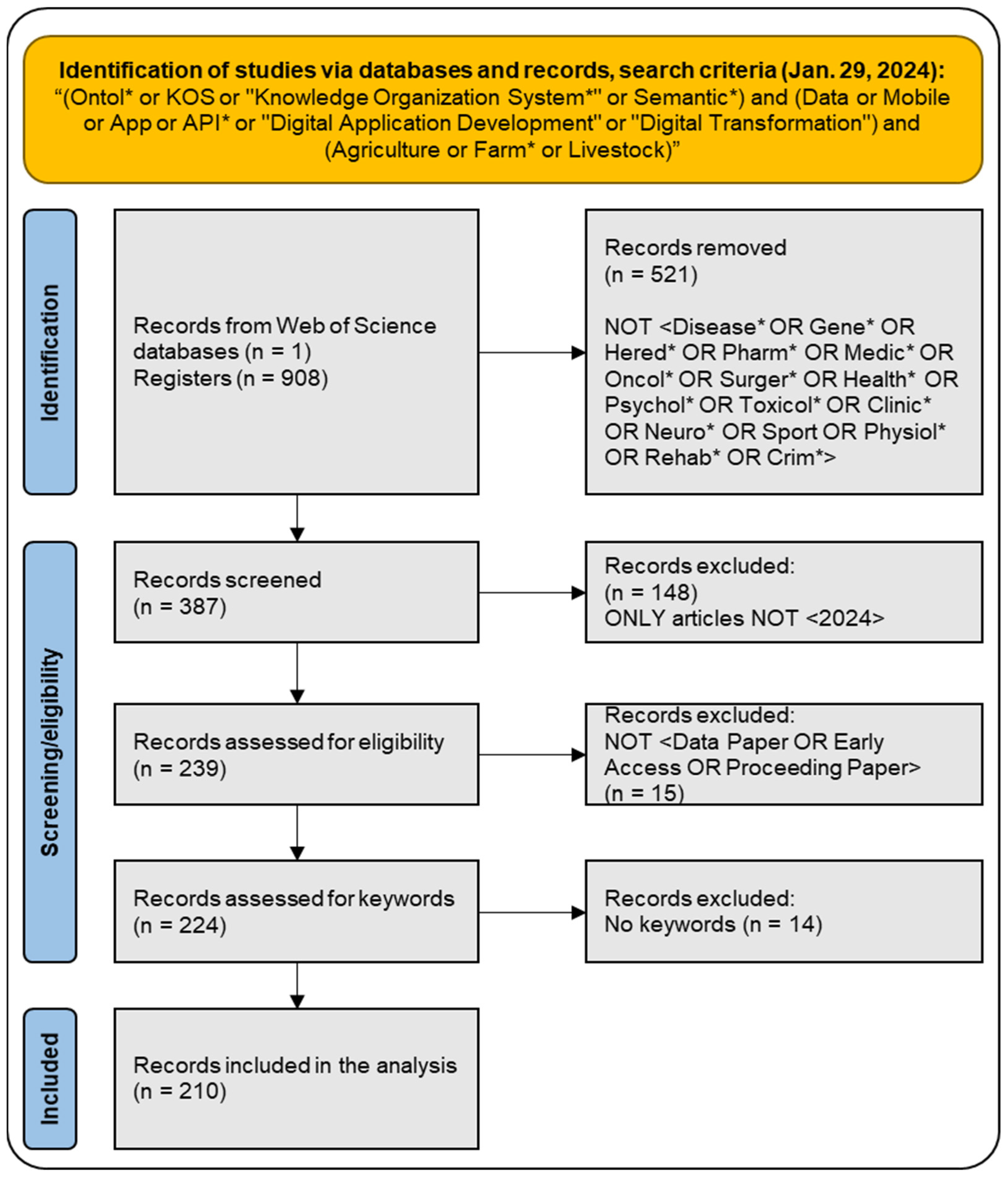


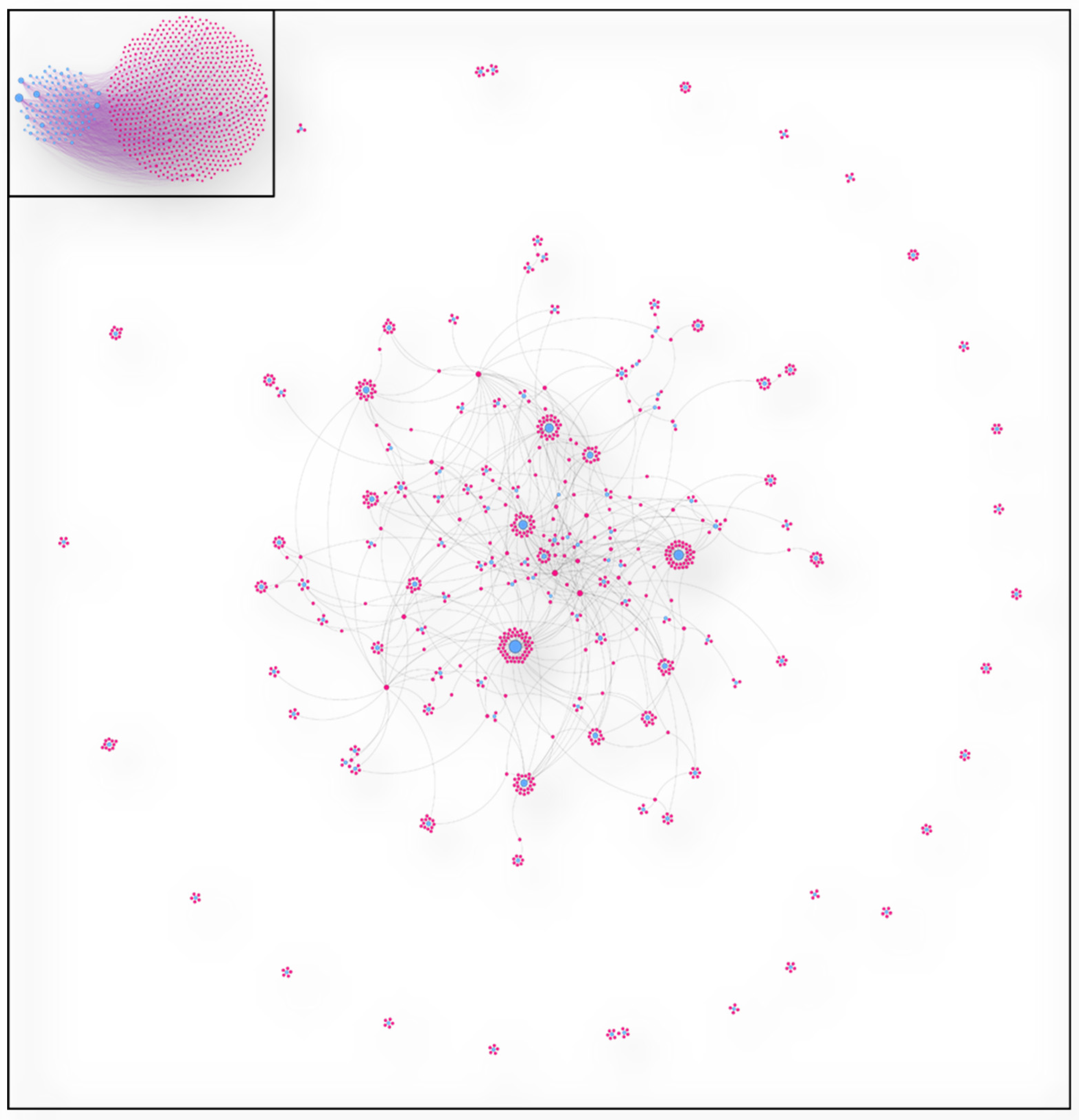
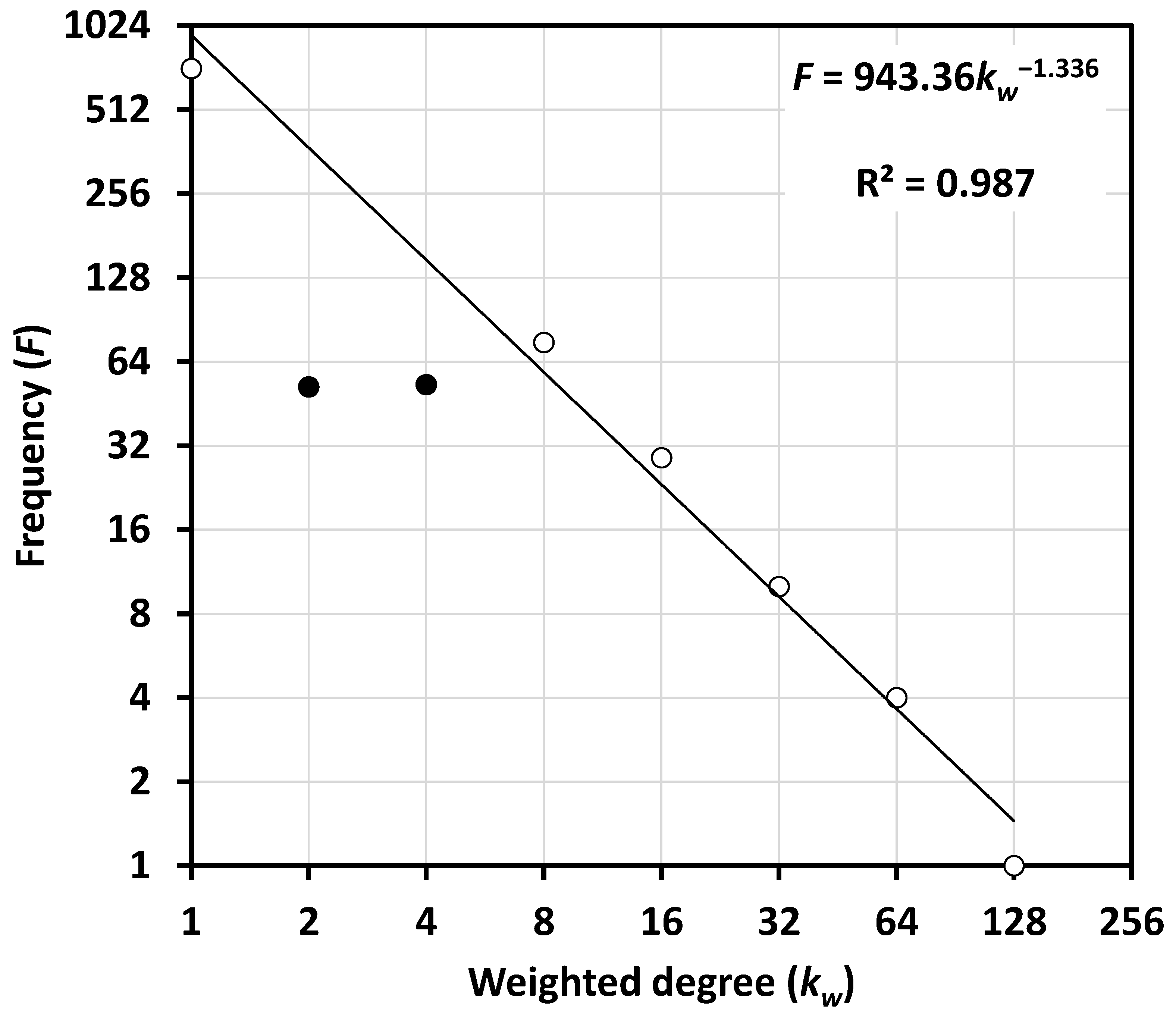
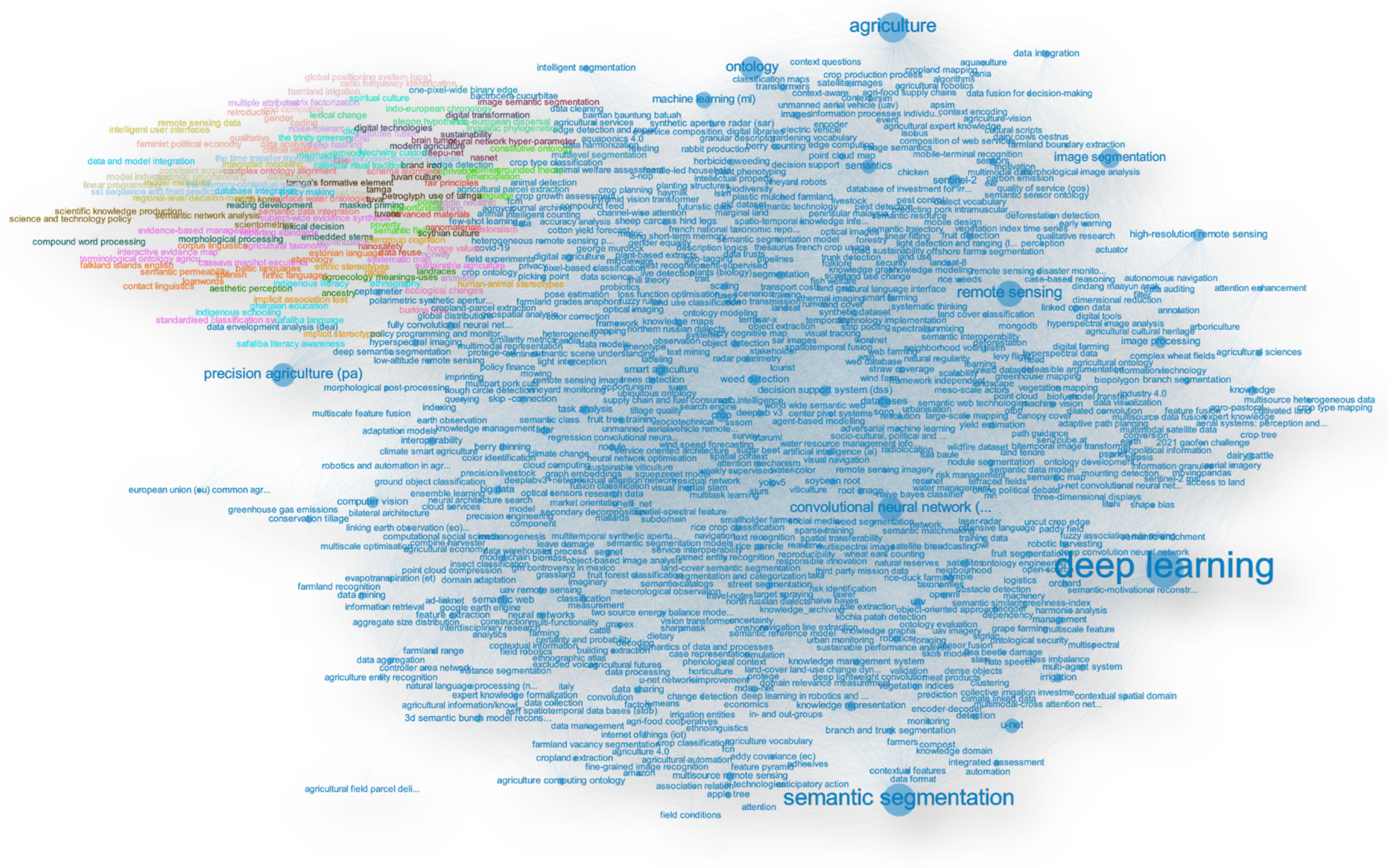

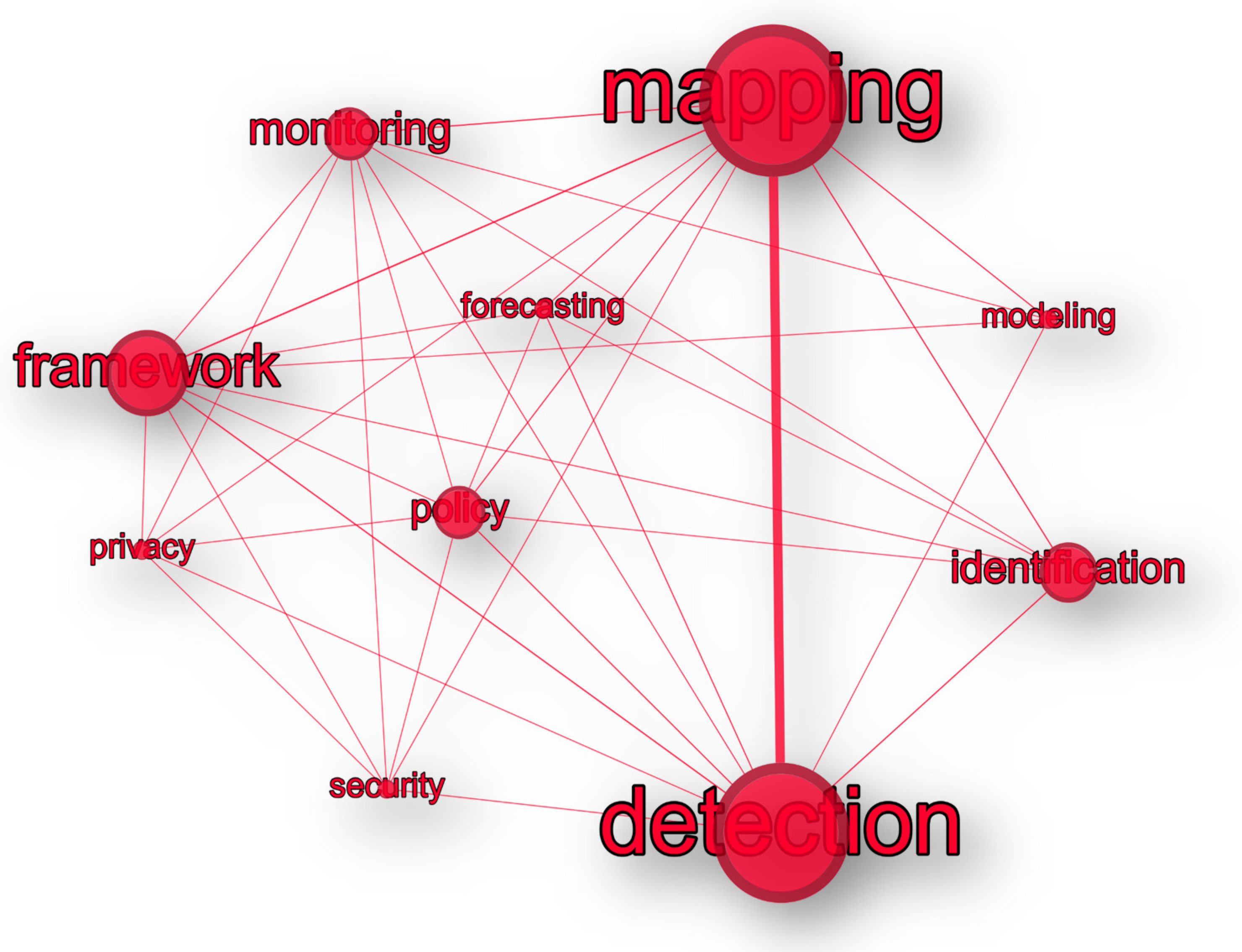
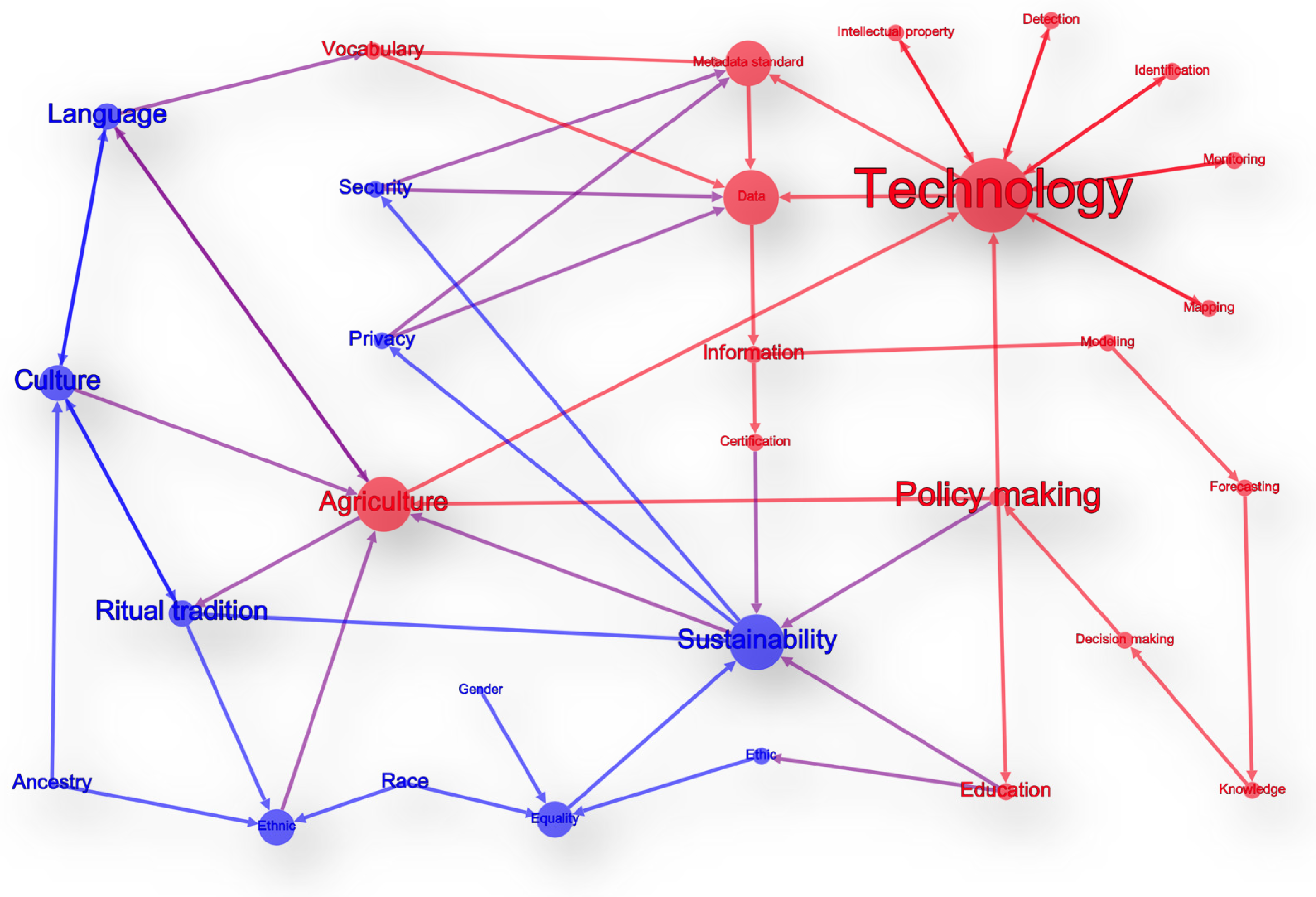
| Cluster | kw | Extracted Concepts | Selected Assets | Selected References |
|---|---|---|---|---|
| 0 | 1–430 * | deep learning (430), semantic segmentation (377), agriculture (344), remote sensing (301), convolutional neural network (cnn) (278), precision agriculture (272), ontology (267), image segmentation (233), machine learning (187), u-net (167) | 7 | n = 95 publications, see Table A1 |
| 1 | 2 | data and model integration, database integration, policy making | 3 | 58 citations [61] |
| 2 | 3 | agricultural parcel extraction, edge detection, multilevel segmentation, one-pixel-wide binary edge | 0 | - |
| 3 | 3 | farmland irrigation, global positioning system (gps), grid computing, radio frequency identification (rfid) | 0 | - |
| 4 | 3 | burkina faso, ecological changes, forage values, pastoralism | 0 | - |
| 5 | 3 | digital technologies, digital transformation, modern agriculture, sustainability | 1 | 2 citations [62]; uncited [63] |
| 6 | 4 | mcstnet, sst sequence and front prediction tasks, the encoder-decoder structure, the memory-contextual module, the time transfer module | 0 | - |
| 7 | 4 | complex ontology alignment, oaei, schema alignment, semantic data integration, surface water ontologies | 0 | - |
| 8 | 4 | north korea, science and technology policy, scientific knowledge production, scientometrics, semantic network analysis | 3 | 7 citations [64] |
| 9 | 4 | integrated modeling, intelligent user interfaces, model metadata, regional-level decision-making, remote sensing data | 2 | 12 citations [65] |
| 10 | 4 | FAIR principles, nanomaterials, data reuse, nanosafety, advanced materials | 1 | 3 citations [66] |
| 11 | 4 | animism, fishing, middle neolithic, neolithization, norway | 0 | - |
| 12 | 4 | indo-european chronology, indo-european dispersal, lexical change, linguistic phylogenetics, steppe hypothesis | 0 | - |
| 13 | 4 | brain tumor, deep u-net, image semantic segmentation, nasnet, neural network hyper-parameter | 0 | unrelated |
| 14 | 4 | aesthetic perception, agroecology, ancestry, landraces, meanings-use | 1 | uncited [67] |
| 15 | 5 | attributes fusion, deep hashing, drone, matrix factorization, multiple attributes, noise-tolerant | 0 | - |
| 16 | 5 | compound word processing, embedded stems, lexical decision, masked priming, morphological processing, reading development | 0 | - |
| 17 | 5 | constraint acquisition, distribution, linear programming, model induction, quadratic programming, set cover | 0 | - |
| 18 | 5 | ethnography, ghanaian education, indigenous literacy, indigenous schooling, safaliba language, safaliba literacy awareness | 0 | - |
| 19 | 5 | ethnic stereotypes, human-animal stereotypes, implicit association test, implicit stereotypes, intergroup cognition, racial | 2 | 1 citation [68] |
| 20 | 6 | coding, critical realism, data analysis, feminist political economy, gender, qualitative, retroduction | 3 | 492 citations [53] |
| 21 | 6 | calendar ritual traditions, didy, klechalny custom, mermaids, provody, spiritual culture, the trinity greenery | 1 | uncited [69] |
| 22 | 8 | brand iron, petroglyph, scythian culture, tamga, tamga’s formative element, tuva, tuvan culture, tuvans, use of tamga | 1 | 1 citation [70] |
| 23 | 9 | agricultural taxonomy, cassava manihot esculenta, evidence-based management, interactive evidence map, reporting standards, standardised classification system, subject-wide evidence synthesis, sustainable agriculture, systematic map, terminological ontology agriculture | 1 | uncited [71] |
| 24 | 4–9 ** | poverty (9), deprivation (5), language (5), power (5), women (5), semantic field (5), constitutive ontology (4), grounded theory (4), emancipation (4), opportunities (4) | 5 | 2 citations [72]; 18 citations [73] |
| 25 | 5–9 ** | loanwords (9), contact linguistics (5), corpus linguistics (5), falkland islands english (5), semantic permeability (5), spanish (5), finnic languages (4), baltic languages (4), estonian language (4), etymology (4) | 0 | - |
| Total | - | - | 31 | - |
| Conceptual Asset | Value | Support (In-Degree) | Influence (Out-Degree) |
|---|---|---|---|
| Agriculture | Material | Ethnic, Language, Policy-making [78,79,80,81,82,83,84,85] | Language, Ritual tradition, Technology [79,80,82,83,85,86,87,88,89] and see also Table A1 |
| Ancestry | Immaterial | - | Culture, Ethnic [74] |
| Certification * | Material | Sustainability [90] | Information [90] |
| Culture | Immaterial | Ancestry, Language, Ritual tradition [74,83,85,91,92] | Agriculture, Language, Ritual tradition [74,83,85] |
| Data | Material | Metadata standard, Privacy, Security, Technology [93,94,95,96] | Information [94] |
| Decision making | Material | Knowledge [97] | Policy making [90,98,99] |
| Detection | Material | Technology (Table A1) | Technology (Table A1) |
| Education | Material | Policy making [99] | Ethic, Sustainability [100,101] |
| Equality | Immaterial | Gender, Race, Ethic [102,103,104] | Sustainability [105] |
| Ethic | Immaterial | Education [106] | Equality [100,101] |
| Ethnic | Immaterial | Ancestry, Race, Ritual tradition [74,83,91,92] | Agriculture [78,90] |
| Vocabulary * | Material | Language [107] | Metadata standard [108] |
| Forecasting | Material | Modeling (Table A1) | Knowledge (Table A1) |
| Gender | Immaterial | - | Equality [109] |
| Identification | Material | Technology (Table A1) | Technology (Table A1) |
| Information | Material | Data (Table A1) | Modeling (Table A1) |
| Intellectual property * | Material | Technology (Table A1) | Technology (Table A1) |
| Knowledge | Material | Forecasting (Table A1) | Decision making (Table A1) |
| Language | Immaterial | Agriculture, Culture, Vocabulary [74,83,91,92,107] | Agriculture [79,80,85] |
| Mapping | Material | Technology (Table A1) | Technology (Table A1) |
| Metadata standard | Material | Language, Privacy, Security, Technology [95,110,111,112] | Data [93], Information technology—Metadata registries (MDR)—Part 6: Registration |
| Modeling | Material | Information (Table A1) | Forecasting (Table A1) |
| Monitoring | Material | Technology (Table A1) | Technology (Table A1) |
| Privacy | Immaterial | Sustainability [113] | Data, Metadata standard [93,95,112,113] |
| Policy making | Material | Decision making [98] | Agriculture, Education, Sustainability, Technology [84,99,114] |
| Race | Immaterial | - | Equality, Ethnic [102,103,104] |
| Ritual tradition | Immaterial | Agriculture [87,89,92] | Culture, Ethnic [74] |
| Security | Immaterial | Sustainability [113] | Data, Metadata standard [93,95,112] |
| Sustainability | Immaterial | Education, Equality, Policy making [84,99,105,109] | Agriculture [84] |
| Technology | Material | Detection, Identification, Intellectual property, Mapping, Monitoring, Policy making [114] and Table A1 | Data, Detection, Identification, Intellectual property, Mapping, Monitoring, Metadata standard [112] |
| Conceptual Asset | Value | Influence | Support |
|---|---|---|---|
| Technology | Material | 7 | 7 |
| Sustainability | Immaterial | 5 | 3 |
| Agriculture | Material | 5 | 3 |
| Data | Material | 5 | 1 |
| Metadata standard | Material | 4 | 1 |
| Culture | Immaterial | 3 | 3 |
| Equality | Immaterial | 3 | 1 |
| Ethnic | Immaterial | 3 | 1 |
| Language | Immaterial | 2 | 3 |
| Ritual tradition | Immaterial | 2 | 3 |
| Ethic | Immaterial | 1 | 1 |
| Vocabulary | Material | 1 | 2 |
| Privacy | Immaterial | 1 | 2 |
| Security | Immaterial | 1 | 2 |
| Decision making | Material | 1 | 1 |
| Detection | Material | 1 | 1 |
| Education | Material | 1 | 2 |
| Forecasting | Material | 1 | 1 |
| Identification | Material | 1 | 1 |
| Information | Material | 1 | 2 |
| Knowledge | Material | 1 | 1 |
| Mapping | Material | 1 | 1 |
| Modeling | Material | 1 | 1 |
| Monitoring | Material | 1 | 1 |
| Policy making | Material | 1 | 4 |
| Intellectual property | Material | 1 | 1 |
| Certification | Material | 1 | 1 |
| Ancestry (Heritage) | Immaterial | 0 | 2 |
| Gender | Immaterial | 0 | 1 |
| Race | Immaterial | 0 | 2 |
Disclaimer/Publisher’s Note: The statements, opinions and data contained in all publications are solely those of the individual author(s) and contributor(s) and not of MDPI and/or the editor(s). MDPI and/or the editor(s) disclaim responsibility for any injury to people or property resulting from any ideas, methods, instructions or products referred to in the content. |
© 2024 by the authors. Licensee MDPI, Basel, Switzerland. This article is an open access article distributed under the terms and conditions of the Creative Commons Attribution (CC BY) license (https://creativecommons.org/licenses/by/4.0/).
Share and Cite
Bergier, I.; Barbedo, J.G.A.; Bolfe, É.L.; Romani, L.A.S.; Inamasu, R.Y.; Massruhá, S.M.F.S. Framing Concepts of Agriculture 5.0 via Bipartite Analysis. Sustainability 2024, 16, 10851. https://doi.org/10.3390/su162410851
Bergier I, Barbedo JGA, Bolfe ÉL, Romani LAS, Inamasu RY, Massruhá SMFS. Framing Concepts of Agriculture 5.0 via Bipartite Analysis. Sustainability. 2024; 16(24):10851. https://doi.org/10.3390/su162410851
Chicago/Turabian StyleBergier, Ivan, Jayme G. A. Barbedo, Édson L. Bolfe, Luciana A. S. Romani, Ricardo Y. Inamasu, and Silvia M. F. S. Massruhá. 2024. "Framing Concepts of Agriculture 5.0 via Bipartite Analysis" Sustainability 16, no. 24: 10851. https://doi.org/10.3390/su162410851
APA StyleBergier, I., Barbedo, J. G. A., Bolfe, É. L., Romani, L. A. S., Inamasu, R. Y., & Massruhá, S. M. F. S. (2024). Framing Concepts of Agriculture 5.0 via Bipartite Analysis. Sustainability, 16(24), 10851. https://doi.org/10.3390/su162410851








